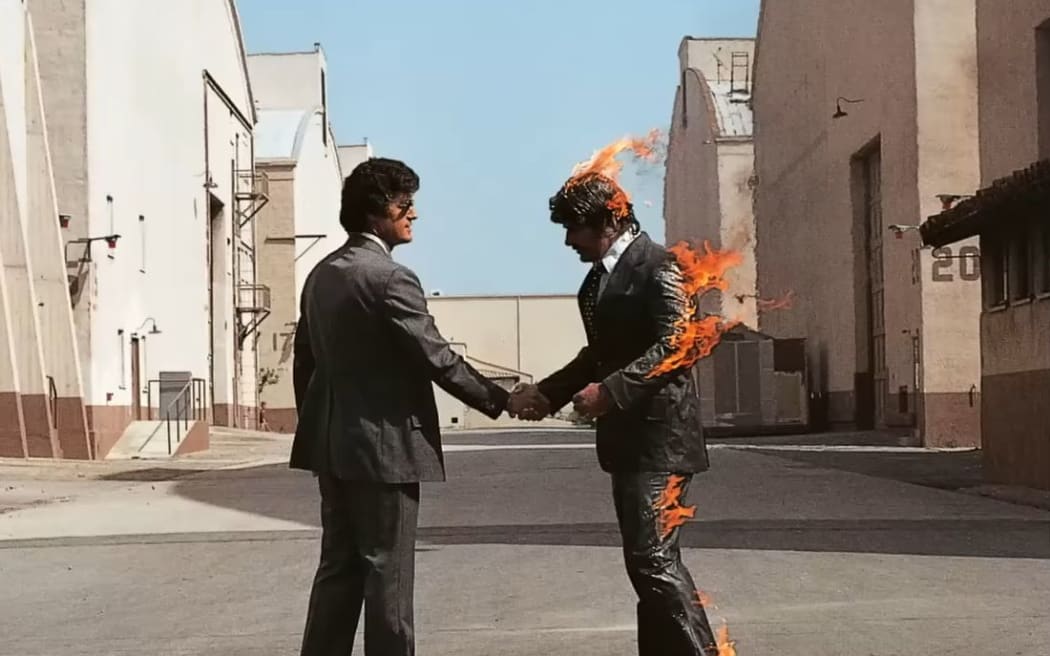There was a time when the album cover was a significant cultural statement.
In the late 1960s and 1970s, as rock began to take itself more seriously, artists started to insist the covers of their albums reflected the music within.
Design studio Hipgnosis were the creators of some of the most famous imagery in 20th century rock music - from the prism of Pink Floyd's Dark Side of the Moon to the all-star prison breakout on the front of Wings' Band on the Run.
They created hundreds of record sleeves for artists like Led Zeppelin, 10cc, Wings, ELO, Emerson Lake and Palmer, and above all, Pink Floyd.

Photo: Screenshot
The New Zealand Film Festival is about to premiere a new film about Hipgnosis - Squaring the Circle by photographer and director Anton Corbijn.
The album cover, pre-internet, was the only way to glean information about a band, Corbijn tells Simon Morris.
“The significance of album sleeves in the ‘70s was there was almost no other way of getting information about the record, apart from what the band chooses to put on the sleeve.
“So it’s not just a visual image, but also when you open it up all the written information about tracks and who played on tracks and recorded etc. And any messages they wanted to give to the people who bought the record.
“So that was all part of the pleasure of putting an album on, reading all the liner notes, all the sleeve information while you listen to the music.”
Hipgnosis was founded by Storm Thorgerson and Aubrey ‘Po’ Powell in Cambridge.
Cambridge in the late 60s had a fertile musical scene, and was home to emerging counter culture bands such as Pink Floyd and Soft Machine.
“They met because they lived on opposite sides of the street. And Powell was quite young. I think he was 16 and lived on his own and had no father anyway.
“And Storm was living with his mother, but his mother was very liberal. I think she was from Finland.
“They were very, very open minded. So, he had always a lot of people around to play records and smoke dope.
“So, there was these cool cats going into that house and he, [Powell] plucked up the courage to also knock on the door. And that's how he met Storm.”
The two were chalk and cheese, he says.
“Storm passed away before I started making this documentary. So, I never met him in real life. So, I depended on the stories of various people, but he seemed to be a controversial figure, and somebody who loved to have an argument.”
‘Po’ Powell was a more convivial, likable character, he says.
Soon Hipgnosis crossed paths with Pink Floyd and got the gig to design the cover of A Saucerful of Secrets, the band's second album.
“They somehow made it work in an unusual way, with lots of bits of pieces. They stole from all kinds of books and photographed it and put it all together.
"And then in the end, they had put a small piece of Pink Floyd on it shot on infrared film, so it was weird looking, and it fitted totally, and I think it’s not a bad sleeve - from there, they went on to do bigger things.”
Hipgnosis set up shop in London and were soon working with the biggest names in rock music, he says.
The Atom Heart Mother album sleeve cemented their reputation, Corbijin says.
“Atom Heart Mother is I think my favourite sleeve of their, this is just a picture of a cow, put on a sleeve it's so powerful.
“There's no title or band name and that's how they wanted it. And that's what Pink Floyd liked. And I think that audacity helped them getting noticed.”
The documentary is shot in black and white, apart from the album covers, he says.
“During the making of it I realised the amount of stock footage I had to use from the 60s and 70s, and old interviews and bits and pieces, aesthetically it was all over the place, I felt that the only way to get some harmony going was to make everything black and white, and then keep the record sleeves as the beautiful, colourfull things in your life that they are.”
Hipgnosis’ ascent coincided with the golden age of the record business, money was flowing in and budgets rocketed, he says.
Paul McCartney insisted on getting a statue and shooting it at the top of the Alps, The Nice had 60 huge red balloons floating in the desert for a cover - none of it through digital trickery.
“I love the fact that they did things for real or did it later in the studio with scissors and glue. It's more interesting than doing these things digitally."
More famous covers followed; Pink Floyd’s Wish You Were Here shows a man shaking hands with another man who is on fire.
“In those days, when you have an idea of putting a man on fire, you have to put them on fire, there was no other way to do it.
“So they had a stuntman who was willing to be standing there and be on fire, until I think the wind went the wrong direction and they stopped it. But it's a great, great cover. It's just unbelievable.
“And then they put a black plastic bag around it, so you had to cut open the black plastic bag, and then take the record sleeve out to see it with.”

Pink Floyd's 'Wish You Were Here' album cover, designed by Hipgnosis. Photo: Screenshot
They went on to work with Wings, Led Zeppelin and 10 CC but as the decade wore on, they became associated with the grandiosity that the new punks on the block detested, he says.
“They worked for what they called the dinosaurs of rock, bands like Led Zeppelin, they were seen like that at the time.
“And they shared an office, well there was a rehearsal space behind the office, that interestingly enough, was rented by the Sex Pistols.
“And Johnny Rotten, would wear a t shirt saying, ‘I hate Pink Floyd’ and he would walk through the building.
“So, they didn't like that so much. I think.”
Eventually Storm and Po fell out and went their separate ways, neither talking to the other for decades.
“It was about money, really. And then they didn't speak to each other for a really long time. So, the movie shows that sort of brotherhood that they had with a lot of love, and then the loss, but then they made up before Storm died.”

